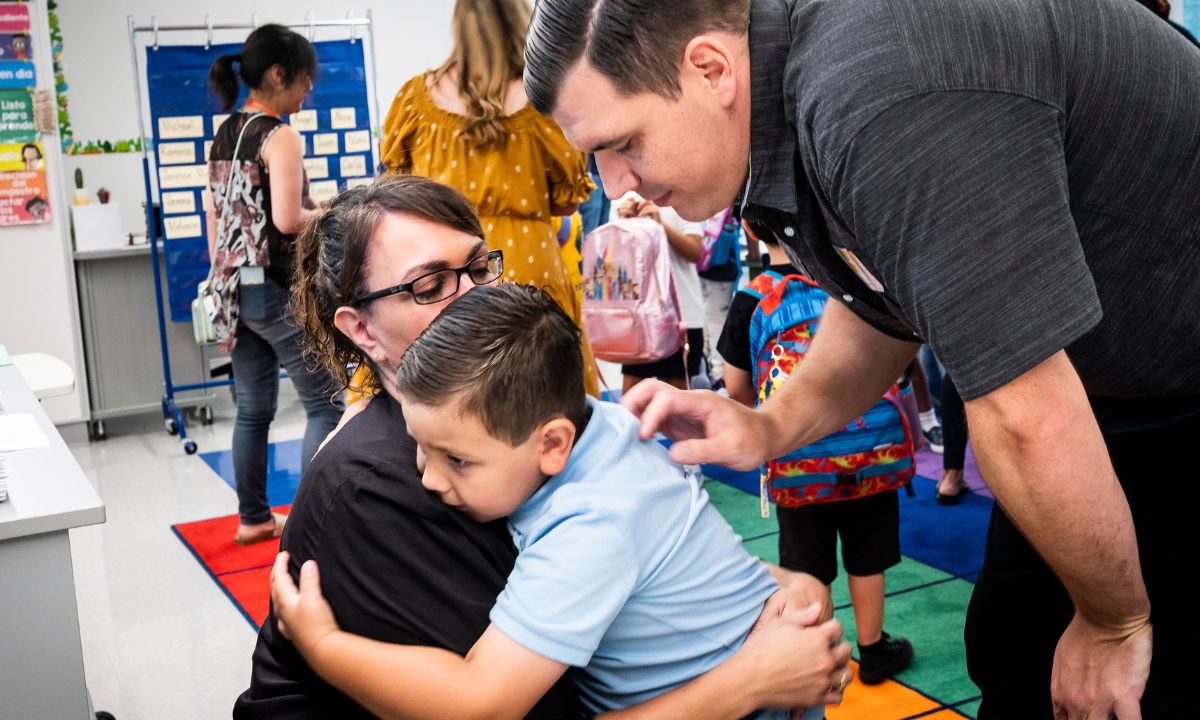We’re Not Protecting Children. We’re Recycling Their Trauma
Swaminathan: Before reporting families to the child welfare system, educators should ask how to support their needs better.

Get stories like this delivered straight to your inbox. Sign up for The 74 Newsletter
I remember the case of a 6-year-old boy whose teacher called child protective services because he had missed school one too many times. No one asked why. If they had, they would’ve heard about the eviction notice taped to the front door, the backpack still stuffed from the rushed move, the air mattress where he now slept curled beside his baby sister. His parents were working two jobs each, leaving at dawn and returning long after bedtime, doing everything they could to keep food on the table and a roof overhead.
He wasn’t unsafe. He wasn’t unloved. He was just missing too many days of school: seven, to be exact, the unexcused limit. And that was enough to trigger an investigation. Just like that, he became one of more than 3 million children investigated by child welfare services each year — over 8,000 every single day. Over 70% of confirmed cases are for “neglect,” a vague, inconsistently defined category that often just reflects poverty.
Education personnel — teachers, counselors, and school staff — make the second-highest number of reports to child welfare services every year, I’ve found in my work researching the child welfare system. While the intentions are often good, the system often punishes families struggling with poverty, addiction, or trauma — not abuse. And once inside, these children are placed into systems that deepen, rather than heal, the original pain.
This is not protection. It is harm, simply by another name.
Children placed in foster care are four times more likely to experience sexual abuse than those who remain at home, and 10 times more likely when placed in group homes. The trauma doesn’t end there. One in three parents involved in child welfare today were themselves in foster care. California reports a 25% re-entry rate within one year of reunification, driven largely by untreated mental health or substance use, not new abuse.
And most chilling of all, over 60% of child sex trafficking victims in the U.S. have spent time in foster care. Many are trafficked while missing from foster care. In 2024 alone, over 23,000 children disappeared from state custody — and a significant number were later identified as victims of sex trafficking.
Without mental wellness at the center, the child welfare system doesn’t just fail. It recreates and sometimes exacerbates the very harm it claims to prevent.
Across the country, models centered on healing are showing what’s possible when we meet families with care instead of immediately extracting their children. As a World Bank scholar and the founder and CEO of Parity Lab, an organization that has supported efforts across the world to end the cycle of trauma, I have seen the impact of community-rooted, trauma-informed programs that prioritize wellness over surveillance.
Drawing on my training, I conducted an 18-month evaluation of the PACE program, an educational neglect prevention program in Olmsted County, Minnesota. I found that re-entry rates dropped significantly, both in the short and long term. The program primarily served children of color, who made up 60% of neglect reports despite comprising only 35% of the student population. PACE created safe spaces, trust, and skill-building — addressing risk factors early and reducing long-term involvement in child welfare.
Similar results exist nationwide. Los Angeles’ UP4Youth program uses specially trained peer navigators and reduces re-entry into foster care, showing that youth-led healing is effective. In New York’s Strong Starts Court Initiative, judges partner with mental health professionals to stabilize families through therapeutic interventions, resulting in faster reunification and better long-term outcomes.
What unites these models is their focus on healing, not punishment. A truly healing-centered system has three defining characteristics:
First, systems awareness, not just individual blame. These approaches look beyond isolated “cases” to ask: What happened to this family, and what systemic forces shaped their situation? They take into account poverty, racism, community disinvestment, and intergenerational trauma. That means working with community organizations, investing in housing and mental health care, and rewriting policies that punish poverty instead of addressing its root causes.
Second, psychological and emotional safety, not just physical safety. Traditional child welfare systems focus almost exclusively on physical harm. But healing requires us to ask: “Will this child be harmed more by staying, or by being removed?” A healing-centered system weighs both forms of harm. As legal scholar Shanta Trivedi has argued in The Harm of Child Removal, separation is not a neutral act; it often inflicts its own kind of trauma, particularly for children of color who are disproportionately separated from their families.
And third, rebuilding from within. Healing-centered systems support the emotional resilience of the adults who shape a child’s daily environment: teachers, social workers, family coaches, and therapists. They must not only regulate their own stress, but also help caregivers and children build emotional tools to stay grounded. It also means embedding supports — like supervision, peer learning, and trauma-informed training — so this work is sustainable.
Many people still picture child welfare as a virtuous system that rescues battered children and places them with loving families. But that’s not how it actually works. Anyone can report you to child protective services: a neighbor, a teacher, even a stranger. When the person reporting doesn’t understand the trauma of removal, or the realities of foster care, well-intentioned calls often end up making things worse.
So instead of asking, “Should I report?,” we need to ask: “How can I support this family better?”
We deserve better. Our children do too.
Get stories like these delivered straight to your inbox. Sign up for The 74 Newsletter

;)
